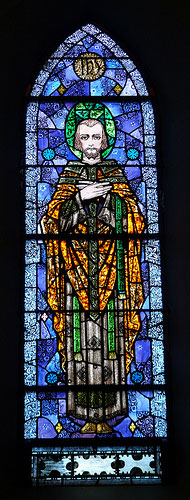
Feastday: January 1
Birth: 962
Death: 1039
William of Dijon is also known as William of St. Benignus. He was the son of Count Robert of Volpiano. William was born in the family castle on San Giuglio island in lake Orta near Nocera while his father was defending the island against the attacking Emperor Otto, who became his sponsor when he captured the island. William was entered into the Benedictine Abbey of Locadio when he was seven, became a monk there, and joined St. Majolus at Cluny in 987. He reorganized St. Sernin Abbey on the Rhone, was ordained in 990, named abbot of St. Benignus at Dijon, and built the Abbey into a great center of spirituality, education, and culture, and the mother monastery of some forty monasteries in Burgundy, Lorraine, Normandy, and Northern Italy. He traveled widely, spreading the Cluniac reform. He died at Fe'camp Monastery in Normandy which he had rebuilt on January 1. His feast day is January 1st.
Saint William of Volpiano (Italian: Guglielmo da Volpiano; French: Guillaume de Volpiano) also of Dijon, of Saint-Benignus, or of Fécamp (June/July 962 – January 1, 1031) was a Northern Italian monastic reformer, composer, and founding abbot of numerous abbeys in Burgundy, Italy and Normandy.
Biography
 Isola San Giulio; William of Volpiano was born here in 962 AD
Isola San Giulio; William of Volpiano was born here in 962 AD Abbey of Fécamp
Abbey of Fécamp
Not much is known about him. The main source is a Vita of the monk Raoul Glaber, a novice who accompanied William and who sometimes regarded his master as a rival, but also as a mentor who encouraged his work as a chronicler.
William was born on the family citadel on the island of San Giulio, Lake Orta, Novara, Piedmont. The son of Count Robert of Volpiano, he was born during an assault on the citadel by the Emperor Otto. The assault being successful, Otto became the sponsor and patron of Count Robert's son.
The fourth son of Count Robert, in 969, at the age of seven, he began his education at the Benedictine abbey at Locadio, Vercelli. He became a monk at this abbey. In 987, he became a monk at the Abbey of Cluny under Saint Majolus. Zealous for reform, Saint Majolus had reorganized Saint Sernin Abbey on the Rhône River.
William was ordained in 990 and served as abbot of Saint Benignus' Abbey at Dijon, dedicated to Saint Benignus of Dijon. Under William's direction, and his zeal for the Cluniac reform, St. Benignus' became a center of spirituality, education, and culture. It also became the mother house of some forty other monasteries in Burgundy, Lorraine, Normandy, and northern Italy.
In 1001, he was called to rebuild the destructed Abbey of Fécamp (present-day department of Seine-Maritime) by Richard II, where the Dukes of Normandy had their palace and had chosen to be buried. William had to supervise the (re)construction and to found several abbeys in Normandy (Bernay, and Mont Saint-Michel). In 1015 he became abbot of Jumièges Abbey.
He was chosen as building contractor for Mont Saint-Michel in the 11th century. He designed the Romanesque church of the abbey, daringly placing the transept crossing at the top of the mount. Many underground crypts and chapels had to be built to compensate for this weight. These formed the basis for the supportive upward structure that can be seen today. He also rebuilt the Abbey of Saint-Germain-des-Prés.
William died of natural causes at Fécamp.





